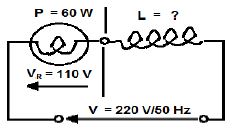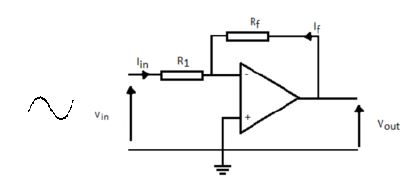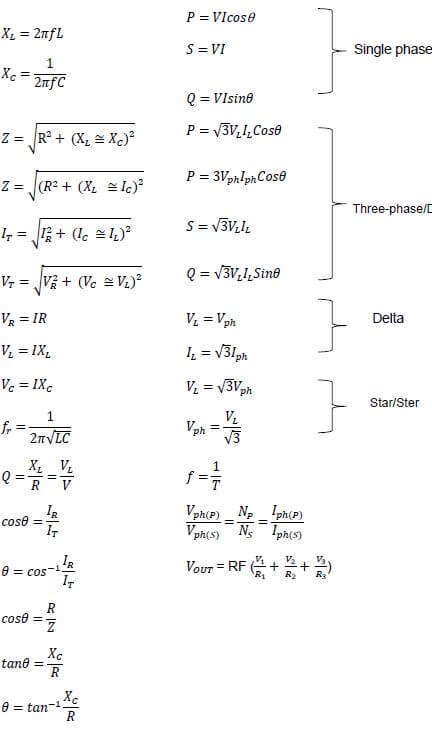ELECTRICAL TECHNOLOGY GRADE 12 QUESTIONS - NSC PAST PAPERS AND MEMOS SEPTEMBER 2017
Share via Whatsapp Join our WhatsApp Group Join our Telegram GroupELECTRICAL TECHNOLOGY
GRADE 12
NSC PAST PAPERS AND MEMOS
SEPTEMBER 2017
INSTRUCTIONS AND INFORMATION
- Answer ALL the questions.
- Sketches and diagrams must be large, neat and fully labelled.
- ALL calculations must be shown, and correctly rounded off to TWO decimal places.
- Answers must be numbered correctly according to the numbering system used in this question paper.
- Non-programmable calculators may be used.
- Show the units for all answers of calculations.
- A formula sheet is provided at the end of the question paper.
- Write neatly and legibly.
QUESTIONS
QUESTION 1: OCCUPATIONAL HEALTH AND SAFETY
1.1 Explain why no person under the influence of drugs may enter or remain in a workplace where machinery is used. (2)
1.2 Name TWO electrical devices that protect equipment under fault conditions. (2)
1.3 Explain the negative impact HIV/Aids has on productivity in the electrical workshop. (2)
1.4 Whose responsibility is it to maintain safety in an electrical technology workshop? Motivate your answer. (3)
1.5 State ONE unsafe condition that may lead to an accident in an electrical technology workshop. (1)
[10]
QUESTION 2: THREE-PHASE AC GENERATION
2.1 In a balanced three-phase delta-connected circuit, the phase voltage is 380 V and the phase current is 12 A. If the phase angle is 25°, calculate the following:
2.1.1 The true power (3)
2.1.2 The apparent power (3)
2.2 A small alternator supplies power to a balanced inductive load. The current in each phase of the alternator is 20 A and it lags the voltage by 30°. The phase voltage is 220 V. Calculate the line voltage if the coils of the alternator are connected in star. (3)
2.3 Give ONE reason why electricity is generated in three-phase and not in single phase. (1)
2.4 Name the type of power factor that a three-phase generator has, and explain why it has such a type of power factor. (3)
2.5 State the function of a kilowatt-hour meter. (1)
2.6 How many electrical degrees apart are the three coils placed in three-phase generation? (1)
2.7 Draw a voltage phasor diagram that represents a three-phase supply. (4)
2.8 Indicate whether the reading on a voltmeter when measuring an AC voltage is a maximum value, average value or effective/rms value. (1)
[20]
QUESTION 3: THREE-PHASE TRANSFORMERS
3.1 Name and explain TWO types of losses that occur in transformers. (4)
3.2 The delta-connected primary winding of a three-phase transformer is supplied with 11 kV. The secondary winding is star-connected and supplies 400 V to a balanced star-connected load of 10 kW with a power factor of 0,8. Calculate the following at full load:
Given: Vp = 11 kV
VS = 400 V
P = 10 kW
Cos θ = 0,8
3.2.1 The total kVA of the load (3)
3.2.2 The secondary line current (3)
3.2.3 The secondary phase current (2)
3.3 Describe why the secondary winding of a transformer must be connected in star if the transformer is to supply both a domestic and an industrial load. (3)
3.4 Name THREE causes of heat build-up in transformers. (3)
3.5 Explain what will happen to the primary current of an ideal transformer if the load is doubled. (2)
[20]
QUESTION 4: THREE-PHASE MOTORS AND STARTERS
4.1 After a motor has been started and is running, what other functions does the starter perform? (2)
4.2 Name THREE parts of a three-phase induction motor. (3)
4.3 Explain why a star-delta starter is used to start three-phase induction motors. (3)
4.4 A three-phase 15 kW induction motor is connected in delta to a 380 V/50 Hz supply. The motor is 100% efficient with a power factor of 0,9 at full load.
Give: P = 15 kW
V = 380 V
f = 50 Hz
η = 100%
Cos θ = 0,9
Calculate:
4.4.1 The current drawn from the supply (3)
4.4.2 The apparent power of the motor (3)
4.4.3 The phase current of the motor (3)
4.5 With reference to insulation resistance tests on the stator of a three-phase induction motor:
4.5.1 Describe why it is important to test the insulation resistance between the windings and the frame of the motor. (2)
4.5.2 Describe the insulation resistance reading you would expect when measuring between the windings of the motor. (3)
4.6 Describe how the direction of rotation of a three-phase motor may be changed. (1)
4.7 Describe why it is necessary to have protective devices as part of motor control. (2)
4.8 Explain what occurs to the three-phase induction motor if one phase fails. (3)
4.9 With reference to a star-delta starter, answer the following questions:
4.9.1 State the function of the starter. (1)
4.9.2 Describe how it achieves this function. (3)
4.10 Describe the principle of operation of an overload unit in a direct-on-line starter. (4)
4.11 Draw and label the control circuit of a direct-on-line starter. (4)
[40]
QUESTION 5: RCL CIRCUITS
5.1 A capacitor with a capacitive reactance of 250 Ω, an inductor with an inductive reactance of 300 Ω and a resistor with a resistance of 500 Ω are all connected in series to a 220 V/50 Hz supply.
Given:
XC = 250 Ω
XL = 300 Ω
R = 500 Ω
VS = 220 V
f = 50 Hz
5.1.1 Calculate the total impedance of the circuit. (3)
5.1.2 Calculate the power factor of the circuit and state whether it is leading or lagging. (4)
5.2
 |
FIGURE 5.2
Calculate:
5.2.1 The resistance of the 60 watt 110 V lamp (3)
5.2.2 The total current flowing through the circuit (3)
5.2.3 The impedance of the circuit (3)
5.2.4 The inductance of the inductor (4)
[20]
QUESTION 6: LOGIC
6.1 Explain the term program when referring to a PLC. (3)
6.2 What do the letters PLC represent? (1)
6.3 Name THREE basic devices used in programming a PLC. (3)
6.4 With reference to an OR-gate, draw the following:
6.4.1 The circuit diagram, using two switches and a lamp to simulate the gate operation (4)
6.4.2 The ladder logic diagram (3)
6.5 Name THREE programming languages used in programming PLCs. (3)
6.6 Simplify the expression below by using Boolean algebra: ![]() (5)
(5)
6.7 Explain why the maintenance of a PLC system (soft-wired system) should be less than that of a relay system (hard-wired system). (2)
6.8 A digital control system uses three positional sensing devices on a conveyor belt in a bottling plant. Each sensing device produces an output of 1 when the position is confirmed. These devices are to be used in conjunction with a logic network of AND / OR gates.
The output of the network (F) is to be 1 when two or more of the sensing devices [Sensor 1(A), 2(B) and 3(C)] are producing signals of 1.
 |
| FIGURE 6.8: CONVEYOR-BELT SYSTEM |
6.8.1 Write down the Boolean equation of the control system. (4)
6.8.2 Simplify the equation using a Karnaugh map. (8)
6.8.3 Draw the gate network of the simplified system. (4)
[40]
QUESTION 7: AMPLIFIERS
7.1 Name THREE applications of an operational amplifier (op amp). (3)
7.2 List THREE characteristics of an ideal operational amplifier (op amp). (3)
7.3 Describe the term open loop with reference to an operational amplifier (op amp). (3)
7.4 Draw the diagram of an operational amplifier (op amp) as an inverting voltage comparator. (3)
7.5 Explain the term positive feedback. (2)
7.6 Explain what effect the very high input impedance (close to infinity) of an op amp will have on the preceding circuit (circuit connected to the input of the op amp). (4)
7.7 Give THREE application of RC phase shift. (3)
7.8
 |
| FIGURE 7.8 OPERATIONAL AMPLIFIER CIRCUIT |
7.8.1 With the given input signal at the non-inverting input, draw both the input and output signals on the same axis. (2)
7.8.2 Explain the function of Rf in the circuit. (3)
7.8.3 Explain what will occur to the gain of the operational amplifier (op-amp) if the value of Rf is decreased. (3)
7.8.4 What is the function of Rin in the circuit? (3)
7.9 Draw the circuit diagram of a Hartley oscillator. (5)
7.10 A comparator circuit compares two electrical signals. State, with a reason, the nature of the output if both signals have exactly the same value. (2)
7.11 In the amplification process the amplitude of the wave form changes, what happens to the frequency of the wave form? (1)
7.12 Explain the term natural oscillation frequency and draw THREE complete cycles to demonstrate natural oscillation frequency. (6)
7.13 Operational amplifiers are commonly used in complex circuits (between stages) to link the stages. State, with a reason, the application (function) of the operational amplifier when utilised between stages. (2)
7.14 Where would you use a non-inverting amplifier? Give ONE example to illustrate your answer. (2)
[50]
TOTAL: 200
ELECTRICAL TECHNOLOGY
FORMULA SHEET